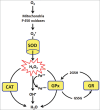Markers of oxidative stress in erythrocytes and plasma during aging in humans
- PMID: 20716923
- PMCID: PMC2835884
- DOI: 10.4161/oxim.3.1.10476
Markers of oxidative stress in erythrocytes and plasma during aging in humans
Abstract
Aging is an inevitable universal biological process, which can be characterized by a general decline in physiological function with the accumulation of diverse adverse changes and increased probability of death. Among several theories, oxidative stress/free radical theory offers the best mechanistic elucidation of the aging process and other age -related phenomenon. In the present paper , we discuss the aging process and have focused on the importance of some reliable markers of oxidative stress which may be used as biomarkers of the aging process.
Figures






References
-
- Rattan SIS. Theories of biological aging: Genes, proteins and free radicals. Free Radic Res. 2006;40:10–12. - PubMed
-
- Harman D. Origin and evolution of the free radical theory of aging: a brief personal history, 1954–2009. Biogerontology. 2009. pp. 9234–9242. - PubMed
-
- Droge W. Free radicals in the physiological control of cell function. Physiol Rev. 2002;82:47–95. - PubMed
-
- Halliwell B, Gutteridge JMC. Free Radicals in Biology and Medicine. 4th ed. New York: Oxford University Press; 2007. Cellular responses to oxidative stress: adaptation, damage, repair, senescence and death; pp. 187–267.
Publication types
MeSH terms
Substances
LinkOut - more resources
Full Text Sources
Medical

